Day 3 - Are we comparing apples with apples? And who likes "them apples"?
(comments: 0)
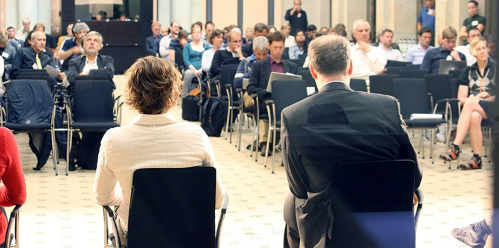
Day 3: Thursday, July 9 2015
The third and final full day of the symposium again included two sessions of talks. The first, entitled "A Comparative View of Climate Engineering Options and Metrics," was aimed at taking a good look at the concepts and terms we use to evaluate and assess different types of CE technologies to establish if researchers from different fields, countries and disciplines are assessing the technologies in a comparable way.
In the first talk of the day, Peter Irvine outlined a way to move towards a comprehensive review and comparison of the impacts and risks of CE methods. His suggested review process included and empirical evaluation of given CE method to attempt to project changes for the system affected, and a normative evaluation to attempt to judge the projected changes as good/bad, just/unjust, etc. Peter envisioned assessing all CE methods in this way and then aggregating the results to put the assessed climate risk of one given CE technology into a broader perspective by comparing its risks with those of other suggested technologies. He suggested that this bottom-up approach would be quite slow and would probably result in a complex picture comprised of patchy assessments with variation across regions. But the advantage of starting with the individual evaluation of each technology and slowly building up the bigger picture one "pixel" at a time would be that the resulting picture would have very detailed resolution. An alternative to the bottom-up approach would be a top-down, derivate approach using the metrics and tools established by the IPCC to assess the key risks of all CE technologies. Starting from the big picture and working down to the individual level would have the advantage of being faster and allowing a more uniform, comprehensive comparison, but would perhaps produce a less detailed picture of the risks of individual technologies. Peter suggested that a combination of both approaches would allow the most comprehensive evaluation.
Duncan McClaren's talk centered around the concept of justice in CE assessment. As CE technologies would have an uneven effect around the world, the "justness" of their deployment is central to the debate. But as Duncan pointed out, justice is not a universal concept. He called for a categorization of the global range of justice concepts, claims and metrics, which could then be used these to compare and contrast the justice of CE techniques, emphasizing the need for a move towards a plurality of concepts of justice, suggesting this could be achieved by means of deliberative and participative approaches to combine contradictory metrics.
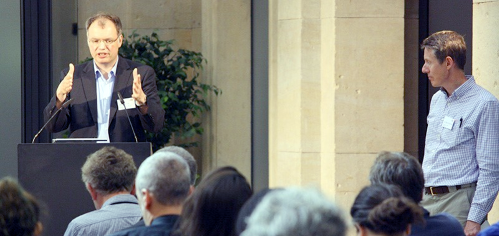
Harald Stelzer followed in the same tone, calling for an overview of the normative criteria for the evaluation of CE technologies that would emphasise distributive impacts and elaborate on ethical aspects of ongoing projects. This would allow an interdisciplinary exchange on the ethical, societal and political feasibility of CE technologies. He pointed out that normative evaluations of CE ask much the same questions as empirical assessments - including how much technologies "cost" and who would benefit how much etc. – but such normative approaches simply provide an added ethical perspective. He concluded that ethical assessment is an essential part of all questions on CE and emphasized that interdisciplinary dialogue is imperative to understanding and evaluating the social, political, economic, ethical and moral dimensions of CE feasibility.
The next talk, given by Hermann Held, focused in on one of the many aspects of CE evaluation listed by the previous speakers: Cost effectiveness. Using economic modelling he showed that if you ignore the risks of SRM deployment, it would completely "crowd out" mitigation in economic climate policy. By comparing economic effects of mitigation with and without added SRM deployment, he showed that about one third of the costs of maintaining a 2 degree target could be saved by using SRM. However, he then went on to show that two thirds of the economic gains of SRM are lost after regional climate risk is taken into account.
Andreas Oschlies took a very long-range view in his talk about modelling the millennial effects of CE deployment. His model runs looked at the state of the climate system in 3000 after multiple centuries of large-scale deployment of a range of CE techniques, including stratospheric aerosol injection, iron fertilization, alkalinity enhancement and artificial upwelling in the ocean, and afforestation on land. The simulations showed that the only two technologies which had a high impact in a high emission world over a long period of time were stratospheric aerosols and ocean upwelling, but there was no future "mission accomplished moment" in which the climate returned to a stable state and CE could safely be terminated. The models showed that termination problem persists even after several hundred years of CE deployment because the CDR technologies included in the simulations did not have a significant effect on the atmospheric CO2 concentration. Andreas emphasized that, due to its incredibly long life-time in the climate system, managing carbon is key in the long term.
Sebastian Sonntag continued the theme of comparing the effectiveness of land, ocean and atmosphere-based CE methods in his presentation on the modeling of stratospheric aerosol injection, alkalinity enhancement and afforestation. In contrast to the previous speaker, Sebastian's simulations indicated that afforestation could have a substantially larger CDR potential, as the model includes terrestrial feedback effects of increased CO2. The models indicated that there was cooling due to CO2 reduction, but as forests are darker than cropland, there was some local warming, and increasing evaporation additionally had a cooling effect. The end effect of large-scale afforestation on the climate was a minor net effect cooling with large regional variations.
Staying with the topic of the effects of land-based, or terrestrial CDR methods, Vera Heck then told us about her investigations into the potential climatic side effects of biomass plantations. Her results challenged the assumption that terrestrial CDR (tCDR) is a "safe and green" CE method by comparing the impacts of tCDR to the biochemical effects human alterations to land use have historically had. Vera's models included biochemical metrics to measure changes in water flux, plant production, land carbon storage and vegetation carbon resistance time. Her simulations showed that tCDR could be expected to cause larger future biochemical changes than humans have caused so far historically by altering natural environments for agriculture, meaning the impacts of large scale biomass plantations would be even larger than past land use changes and would move the climate system into a completely new state. Additionally, Vera showed that plantations could have large effects on biodiversity and food production, that fertilization required for the plantations would be 420 % of current nitrogen demand, and that 30–50 % more water would be required than current land use requires. She therefore summarized that her models indicate that tCDR is not a "green" option.
Jessica Strefler then went on to present her work on the integrated assessment of mitigation and CDR. She looked at four types of CDR: Bio-energy with carbon capture and storage (BECCS), afforestation, direct air capture and terrestrial enhanced weathering and compared them based on price, energy and land use requirements. Comparing the land use of the different CDR methods, Jessica showed that as unrestricted afforestation and BECCS are expected to reduce the amount of land available for food crops, both these methods are expected to cause food prices to increase dramatically. Despite these problems, Jessica's work showed that CDR could play a key role in achieving low stabilization of carbon in the climate system, and that its strategic value lies in compensating the emissions that are most expensive to reduce.
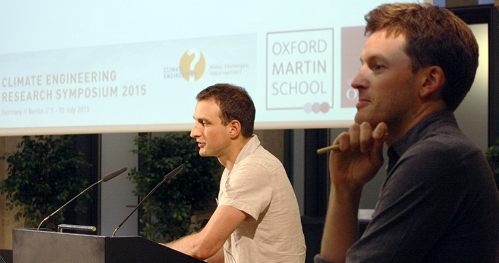
Before we broke for lunch the audience and a panel of the session's speakers were given the chance to discuss any open questions raised during the day. Points made during the panel discussion included a reiteration that concepts of justice are always contested, and obtaining an overview over the range of these concepts essential to communicate on CE. However the open question remained as to whether these multitude of justice concepts would be useful for comparing types of CE responses. With regard to questions of the justice of CE deployment, it became clear that the intentionality would play a huge role, and that thus far there has not been much consideration of the topic.
Another issue discussed is that it is essential to make explicit what models of the effects of CE deployment are being compared to. When making empirical and normative evaluations of CE, It makes a big difference if the reference climate being referred to is today's climate or pre-industrial climate or runaway climate change in the future.
Additionally, there was lively discussion about the tension between the need for simplification and the desire for complexity when evaluating CE. While some were of the opinion that it is dangerous to draw general conclusions from general observations, and emphasized that detailed assessment is needed before statements about the effectiveness of specific CE technologies can be made, others pointed out that at the same time we need to reduce complexity to a point that we can make decisions on CE. Additionally, it was suggested that we, as researchers, need to generalize a little to be able to communicate about issues in an interdisciplinary way, as there is not a way to wait until we have a final answer before discussing these topics.
And finally, summarizing the overall take-home message of the session on comparing the concepts and terms we use to evaluate and assess different types of CE technologies, it was empathized that the difficult task of identifying and deciding upon meaningful metrics can only be achieved as part of an interdisciplinary community effort.
After a restorative lunch, we started the afternoon's session on the perceptions of and perspectives on CE research and deployment with new energy. We jumped right into the issue as to what "people" think about CE technologies and why with a presentation by Jack Stilgoe on how the framing of CE affects not only the perception of the field in civil society, but also how members of the research community see their role. Jack described research and experiments as "ways of making and remaking the world" and called on researchers to be aware of their role as frame shapers. He then went on take a closer look at the composition of the field. As CE research is recent, the field is expectedly quite small. It is very interdisciplinary, but some disciplines are more strongly represented than others - what is especially evident is that there is a relative absence of engineers in the field of climate engineering. Jack then addressed the way in which researchers in the field perceive the way scientific enquiry should proceed. Using streetscapes as an analogy, he asked if should we rather delineate a "safe space" by draw red lines around what we consider to be acceptable/unacceptable research and imposing strict entrance criteria, or if we should rather see the field as a "shared space" in which there is no clear delineation between disciplines, blurring lines and removing barriers to participation. Continuing the street analogy, he suggested that, as having shared streets slows traffic, so a shared research space may result in slower science, but the end result has the potential be much more complex and inclusive.
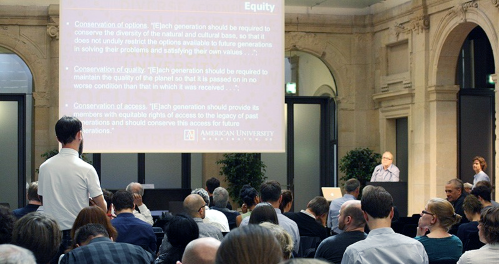
Wil Burns then provided us with an overview of the concept of intergenerational justice and how some CE technologies have the potential to violate principle of intergenerational equity. He took up the topic of the termination effect, suggesting that even if our generation did not stop using it, we would still be transferring a "Damocles sword" to hang over the heads of future generations who will then need to keep using CE to avoid the termination effect, saying this too is a potential violation of principle of intergenerational equity. Other CE related issues which may contravene the principle of intergenerational equity suggested by Wil included that if CE affects the replenishment of the ozone layer, future generations may face increased skin cancer related problems, and if ecosystems are altered, future generations may be denied access to recourses. To reduce the likelihood of this happening, Wil indicated that we should restrict the scope of CE to keep options open for future generations and reduce emissions to reduce the amount of time that CE would need to be used. He went on to argue for a strong legal coupling of any permission to deploy CE to aggressive mitigation.
An overview of the African perspective on CE was provided by Mary Mutiso, who emphasised that the peoples of different regions have potentially very different perceptions about the utility and morality of CE. She pointed out that knowledge about and research on CE is limited in African nations, and expressed the concern that decisions about CE would be imposed upon Africa by the global north. She stressed the need for transparency of research, knowledge transfer and consensus on CE governance to ensure participation by scientists, politicians and the public in as many nations as possible.
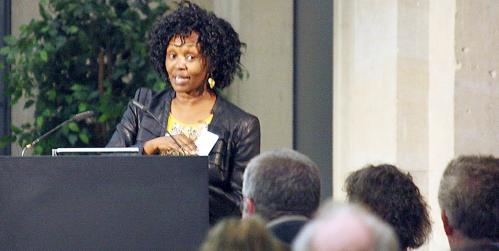
Gert Pönitzsch briefly presented the results of an online survey of CE experts and laypeople which asked how much of the total budget should be spent on mitigation, CDR, adaption and SRM. The results indicated respondents thought mitigation should receive the most funding, and the median amount of budget respondents allocated to CE was 15 %, with CDR receiving the most of that funding. Further questions on what sort of solar aerosol injection (SAI) research should be funded showed that while most respondents supported research, support for limited field research and global field research was much lower among both experts and laypeople. The results Gert presented indicated that there was no bias among CE researchers towards deployment, and that experts were slightly more cautious regarding risks and benefits of SAI than lay people.
Christine Merk went on to show us the results of an experiment to assess whether individuals reduce mitigation efforts when they are informed about SAI. The experiment was organized as an online survey in which each participant was given 10 Euro and told they could use this to buy voluntary carbon offsets (1 Euro per offset) or keep it and do what they liked with it. Participants included a baseline group and group who had been informed about SAI. This information was provided in a way that tried to avoid all framing by keeping the information neutral and included details about potential benefits, negative effects and high uncertainty. The results Christine presented showed that people who were informed about SAI bought more carbon offsets, indicating that knowledge about aerosol injection increases individual mitigation, although she emphasized that it is unclear if this behaviour would carry over into real life.
Next Nils Matzner and Daniel Barben presented details about two studies on the nexus of science and policy and the CE discourse in science, policy and civil society arenas. Daniel emphasized the role of knowledge in the legitimization of political action and the way in which knowledge can create the responsibility to take action. We were shown why who says what in what context to what audience matters in the CE discourse by indicating how statements by high profile speakers Paul Cruzten and Al Gore have the potential to change the course of the debate on CE. Nils presented some results from the discourse analysis of the CE discourse in science, policy and civil society arenas which showed that the terms "governance" and "responsibility" are very central. Other results included that the attribution problem is important for science and science policy interface, while civil society emphasizes negative side effects.
The last talk of the day was given by Tim Kruger. He used analogies to explore the moral implications of the future availability of cheap, safe, scaleable CDR and whether 'can' implies 'ought'. He emphasized that if we could remove CO2 out of the atmosphere, it would crystallise a price for carbon, and questioned why we are pumping so much money into renewables and not into CO2 removal technologies.
After a day packed with interesting presentations and discussions, the session ended with a general discussion and some closing remarks on the idea of "slow science" introduced by Jack Stilgoe. As one participant put it, slow science could be like slow food - better quality, with more criteria considered, but not as fast. It was suggested we could "go slow now to go fast later", but others emphasized that there is a need for speed with relation to CDR innovation. We ended the discussion by agreeing to disagree on some points and left with even more to think about than when we arrived.

Add a comment